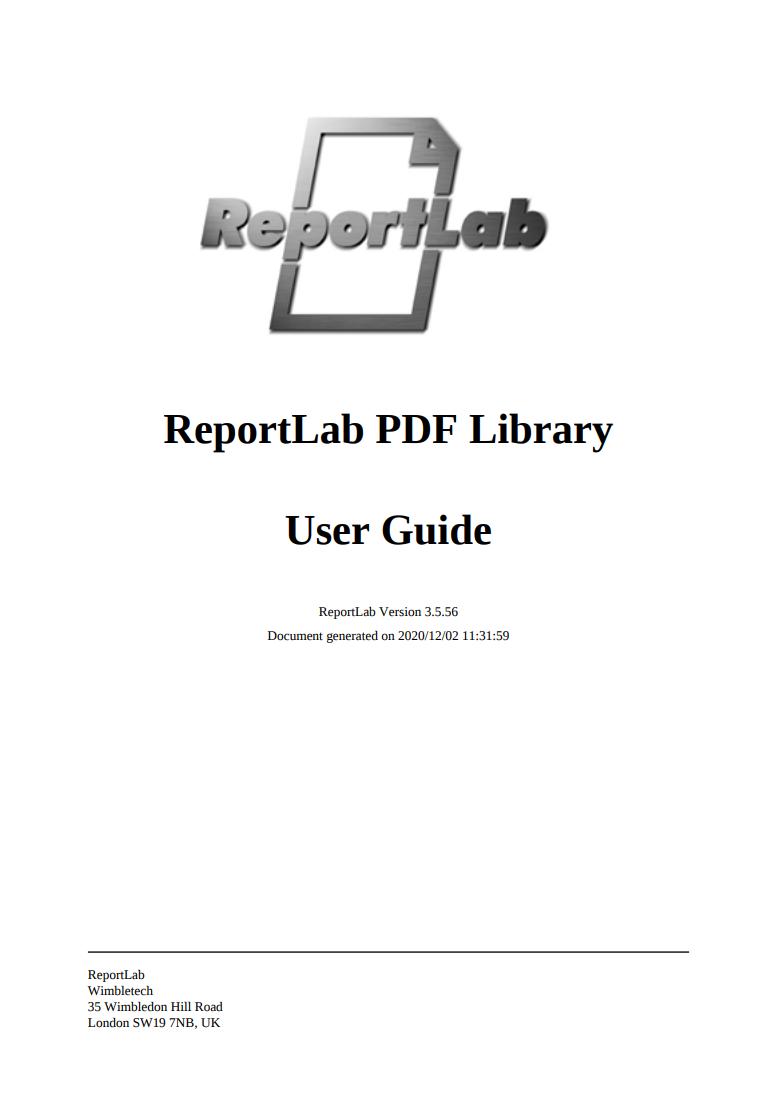
 ReportLab PDF Library. User Guide
ReportLab PDF Library. User Guide
Python
Publicado el 3 de Junio del 2021 por Administrador
4.187 visualizaciones desde el 3 de Junio del 2021
Índice de Contenidos:
Chapter 1 Introduction
1.1 About this document
1.2 What is the ReportLab PDF Library?
1.3 ReportLab's commercial software
1.4 What is Python?
1.5 Acknowledgements
1.6 Installation and Setup
1.7 Getting Involved
1.8 Site Configuration
1.9 Learning More About Python
1.10 Goals for the 3.x release series
Chapter 2 Graphics and Text with pdfgen
2.1 Basic Concepts
2.2 More about the Canvas
2.3 Drawing Operations
2.4 The tools: the "draw" operations
2.5 The toolbox: the "state change" operations
2.6 Other canvas methods
2.7 Coordinates (default user space)
2.8 Colors
2.9 Color space checking
2.10 Color Overprinting
2.11 Standard fonts and text objects
2.12 Text object methods
2.13 Paths and Lines
2.14 Rectangles, circles, ellipses
2.15 Bezier curves
2.16 Path object methods
2.17 Further Reading: The ReportLab Graphics Library
Chapter 3 Fonts and encodings
3.1 Unicode and UTF8 are the default input encodings
3.2 Automatic output font substitution
User Guide Table of contents
3.3 Using non-standard Type 1 fonts
3.4 Standard Single-Byte Font Encodings
3.5 TrueType Font Support
3.6 Asian Font Support
3.7 RenderPM tests
Chapter 4 Exposing PDF Special Capabilities
4.1 Forms
4.2 Links and Destinations
4.3 Outline Trees
4.4 Page Transition Effects
4.5 Internal File Annotations
4.6 Encryption
4.7 Interactive Forms
Chapter 5 PLATYPUS - Page Layout and Typography Using Scripts 65
5.1 Design Goals
5.2 Getting started
5.3 Flowables
5.4 Guidelines for flowable positioning
5.5 Frames
5.6 Documents and Templates
Chapter 6 Paragraphs
6.1 Using Paragraph Styles
6.2 Paragraph XML Markup Tags
6.3 Intra-paragraph markup
6.4 Bullets and Paragraph Numbering
Chapter 7 Tables and TableStyles
7.1 Table User Methods
7.2 TableStyle
7.3 TableStyle User Methods
7.4 TableStyle Commands
Chapter 8 Programming Flowables
8.1 DocAssign(self, var, expr, life='forever')
8.2 DocExec(self, stmt, lifetime='forever')
8.3 DocPara(self, expr, format=None, style=None, klass=None, escape=True)
8.4 DocAssert(self, cond, format=None)
8.5 DocIf(self, cond, thenBlock, elseBlock=[])
8.6 DocWhile(self, cond, whileBlock)
Chapter 9 Other Useful Flowables
9.1 Preformatted(text, style, bulletText=None, dedent=0, maxLineLength=None, splitChars=None, newLineChars=None)
9.2 XPreformatted(text, style, bulletText=None, dedent=0, frags=None)
9.3 Image(filename, width=None, height=None)
9.4 Spacer(width, height)
9.5 PageBreak()
9.6 CondPageBreak(height)
9.7 KeepTogether(flowables)
9.8 TableOfContents()
9.9 SimpleIndex()
9.10 ListFlowable(),ListItem()
9.11 BalancedColumns()
Chapter 10 Writing your own Flowable Objects
10.1 A very simple Flowable
10.2 Modifying a Built in Flowable
Chapter 11 Graphics
11.1 Introduction
11.2 General Concepts
11.3 Charts
11.4 Labels
11.5 Axes
11.6 Bar Charts
11.7 Line Charts
11.8 Line Plots
11.9 Pie Charts
11.10 Legends
11.11 Shapes
11.12 Widgets
Appendix A ReportLab Demos
A.1 Odyssey
A.2 Standard Fonts and Colors
A.3 Py2pdf
A.4 Gadflypaper
A.5 Pythonpoint
En formato pdf. Contiene 134 páginas.

Chapter 1 Introduction
1.1 About this document
1.2 What is the ReportLab PDF Library?
1.3 ReportLab's commercial software
1.4 What is Python?
1.5 Acknowledgements
1.6 Installation and Setup
1.7 Getting Involved
1.8 Site Configuration
1.9 Learning More About Python
1.10 Goals for the 3.x release series
Chapter 2 Graphics and Text with pdfgen
2.1 Basic Concepts
2.2 More about the Canvas
2.3 Drawing Operations
2.4 The tools: the "draw" operations
2.5 The toolbox: the "state change" operations
2.6 Other canvas methods
2.7 Coordinates (default user space)
2.8 Colors
2.9 Color space checking
2.10 Color Overprinting
2.11 Standard fonts and text objects
2.12 Text object methods
2.13 Paths and Lines
2.14 Rectangles, circles, ellipses
2.15 Bezier curves
2.16 Path object methods
2.17 Further Reading: The ReportLab Graphics Library
Chapter 3 Fonts and encodings
3.1 Unicode and UTF8 are the default input encodings
3.2 Automatic output font substitution
User Guide Table of contents
3.3 Using non-standard Type 1 fonts
3.4 Standard Single-Byte Font Encodings
3.5 TrueType Font Support
3.6 Asian Font Support
3.7 RenderPM tests
Chapter 4 Exposing PDF Special Capabilities
4.1 Forms
4.2 Links and Destinations
4.3 Outline Trees
4.4 Page Transition Effects
4.5 Internal File Annotations
4.6 Encryption
4.7 Interactive Forms
Chapter 5 PLATYPUS - Page Layout and Typography Using Scripts 65
5.1 Design Goals
5.2 Getting started
5.3 Flowables
5.4 Guidelines for flowable positioning
5.5 Frames
5.6 Documents and Templates
Chapter 6 Paragraphs
6.1 Using Paragraph Styles
6.2 Paragraph XML Markup Tags
6.3 Intra-paragraph markup
6.4 Bullets and Paragraph Numbering
Chapter 7 Tables and TableStyles
7.1 Table User Methods
7.2 TableStyle
7.3 TableStyle User Methods
7.4 TableStyle Commands
Chapter 8 Programming Flowables
8.1 DocAssign(self, var, expr, life='forever')
8.2 DocExec(self, stmt, lifetime='forever')
8.3 DocPara(self, expr, format=None, style=None, klass=None, escape=True)
8.4 DocAssert(self, cond, format=None)
8.5 DocIf(self, cond, thenBlock, elseBlock=[])
8.6 DocWhile(self, cond, whileBlock)
Chapter 9 Other Useful Flowables
9.1 Preformatted(text, style, bulletText=None, dedent=0, maxLineLength=None, splitChars=None, newLineChars=None)
9.2 XPreformatted(text, style, bulletText=None, dedent=0, frags=None)
9.3 Image(filename, width=None, height=None)
9.4 Spacer(width, height)
9.5 PageBreak()
9.6 CondPageBreak(height)
9.7 KeepTogether(flowables)
9.8 TableOfContents()
9.9 SimpleIndex()
9.10 ListFlowable(),ListItem()
9.11 BalancedColumns()
Chapter 10 Writing your own Flowable Objects
10.1 A very simple Flowable
10.2 Modifying a Built in Flowable
Chapter 11 Graphics
11.1 Introduction
11.2 General Concepts
11.3 Charts
11.4 Labels
11.5 Axes
11.6 Bar Charts
11.7 Line Charts
11.8 Line Plots
11.9 Pie Charts
11.10 Legends
11.11 Shapes
11.12 Widgets
Appendix A ReportLab Demos
A.1 Odyssey
A.2 Standard Fonts and Colors
A.3 Py2pdf
A.4 Gadflypaper
A.5 Pythonpoint
En formato pdf. Contiene 134 páginas.

211 visualizaciones durante los últimos 90 días